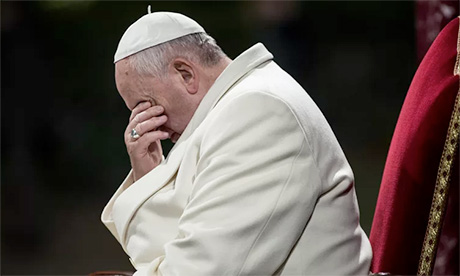Why do Catholics kiss the pope’s ring? And why doesn’t he want them to?
Protocols evolve and changes can be confusing, especially when most people only meet a reigning monarch (or pope) once in their lives.
As we have seen in the past few days, old habits die hard, even when the pope is trying to keep the receiving line moving.
So while Pope Francis might not be a fan of hand and ring kissing, he is actually following the lead of John Paul II and Benedict XVI.
Before the Second Vatican Council, it was customary in most countries for both priests and laity to kiss a bishop’s ring upon greeting him as a sign of respect and obedience.
But times change, and the gesture can also be seen as furthering clericalism and ties to temporal power.
Both Pope Francis and Pope Benedict XVI before him have tried to discourage the practice when the pope is receiving visitors, and Francis was resistant to the practice when he was archbishop of Buenos Aires as well.
While Pope Francis might not be a fan of hand and ring kissing, he is actually following the lead of John Paul II and Benedict XVI. Benedict actually abolished the tradition, but no one followed.
According to the journalist Peter Seewald (in his book-length interview The Light of the World), Pope Benedict XVI actually abolished the tradition of kissing the pope’s hand, “though no one followed the new protocol.”
America’s Vatican correspondent, Gerard O’Connell, notes that when the cardinals came forward at the conclave that elected Pope Francis to express their obedience to him, he tried to stop them from kissing his hand or ring.
He kissed the hands of cardinals from Vietnam and China, as a sign of respect for their witness in the face of religious persecution.
Much of the reverence shown to the papal rings developed out of the tradition of “the fisherman’s ring” owned by the pope.
At least as far back as the 1200s, the signet on the fisherman’s ring was used to seal papal documents.
In that time, seals helped to verify that private documents had not been tampered with or opened in transit.
With modern means of communication, this practice of sealing a document with wax and then pressing the signet into the wax has fallen out of use.
In keeping with this original and rather practical purpose, the ring of the fisherman was traditionally destroyed after the death of a pope.
In the presence of other cardinals, the ring would be smashed with a ceremonial hammer.
At the inauguration of the next pope, a new ring would be presented to the new pope.
Similar traditions and ceremonies were quite common in royal courts throughout Europe in the medieval period.
Another common practice would have been the kissing of a monarch’s ring as a sign of respect for the office and power held by the monarch.
This matches up with the tradition of kissing the pope’s hand and the fisherman’s ring. It also was not limited to the pope: Bishops also receive rings at their episcopal ordinations. Continue reading
